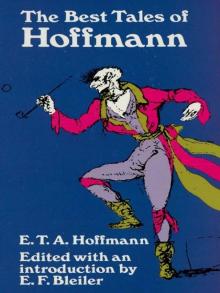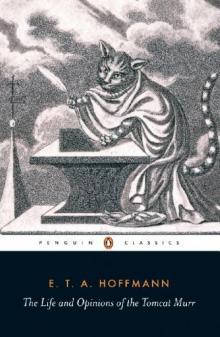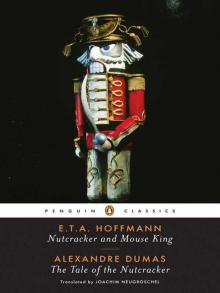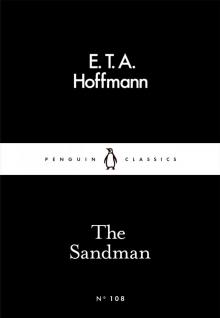- Home
- E. T. A. Hoffmann
The Best Tales of Hoffmann Page 3
The Best Tales of Hoffmann Read online
Page 3
Yet beyond this there are other possible levels of interpretation. It has been noticed that the characters and ideas of “The Golden Flower Pot” are arranged in two series, each with one pole in the world of reality and another in the world of fantasy. Indeed, there is even a sort of identity between the two forms: Serpentina with Veronica, Anselmus with the Registrator Heerbrand, Archivarius Lindhorst with Conrector Paulmann, and so on. According to this interpretation, Anselmus is simply a projection of the Registrator which disappears in the world of fantasy, while the Registrator, giving up his dreams, marries Veronica. She, in turn, recognizes that she cannot possess the Anselmus complex but must be content with the Registrator-turned-Geheimrat.
Both of these interpretations may seem to be far-fetched interpretation for its own sake, but the fact remains that some justification exists for them or comparable unriddlings. Hoffmann’s work is permeated with the concept of personality fragments coming to separate identity and acting as characters. To quote one example which is beyond dispute, in Hoffmann’s remarkable novel The Devil’s Elixir (Die Elixiere des Teufels) the identities of two of the characters, the Monk Medardus and the Graf Viktorin, are so merged and interchanged that the characters themselves do not know where one begins and the other ends.
The heart of “The Golden Flower Pot” is the märchen, or literary myth, that the Archivarius begins in the tavern; it is concluded by a strange glossologia from an Oriental manuscript that Anselmus is copying. The archphilistine of the story calls this märchen “Oriental bombast,” but as the Archivarius replies, it is not only true but important. It recapitulates the central thought of “The Golden Flower Pot” sub specie aeternitatis, stripped of the accidentals of time, space, and personality.
The central idea of this märchen is the birth of poetry, expressed in terms of cosmic symbols drawn from the Naturphilosophie. It tells of the divine spark (phosphorus was the chemical symbol for the nervous fluid or intelligence in some of the systems of the day) which awakens and fertilizes a vegetative life. This in terms of mounting triads (a concept borrowed from the philosophical systems of the day) must die to give birth to a higher principle.
Lindhorst’s märchen is thus a combination of several elements: a pseudobiblical creation statement; an allegory in which details have special meaning, although it is not always clear now what each point means; a fanciful statement of the human situation; and perhaps an ironic spoofing of some of the philosophical systems of the day. Hoffmann, although he was greatly interested in the outgrowths of Schelling’s philosophy and accepted much of it, could be expected to retain a pawky incredulity at certain aspects of it. But perhaps analysis should not be pushed too far; it may be enough to say that this is a numinous statement of life, in which both profound and trivial concepts are fused.
German literature at the end of the 18th century frequently made use of märchen, or literary myths. These often appeared as symbolic kernels or germs within the larger context of a story, offering in a frankly poetic and mythical form the point offered more or less realistically in the full story. The märchen was thus a microcosm within a macrocosm.
This form and its use were not Hoffmann’s invention. Goethe had written an independent allegorical story called “Das Märchen,” which aroused a great deal of criticism among the Romantics, and Wackenroder had incorporated the fairytale of the Naked Saint in his Herzensergiessungen eines kunstliebenden Klosterbruders. Novalis, who represents the high point of the Early Romantic School in Germany, had incorporated two such märchen in his unfinished novel Heinrich von Ofterdingen. Novalis characterized the märchen as being “like a dream vision . . . beyond logic . . . an assembly of wonderful things and happenings . . . a [pregnant] chaos.” This description fits his own work and Hoffmann’s when it is remembered that chaos to the Romantics did not mean an empty waste as it usually does for us, but an infinitely rich, undifferentiated, undiversified “plasma,” out of which universes could be formed.
All in all, it seems unlikely that there ever will be complete agreement about all the details of “The Golden Flower Pot.” Perhaps Hoffmann himself was not entirely clear about his intentions. It would lie more within the realm of the Romantic movement to leave things in a tantalizing mist than to strip them of illusion. The symbol should be permitted to unroll and expand as it will. In any case, the modern reader can exercise his own judgment in deciding what really happened to Anselmus.
“Automata” (“Die Automate”) first appeared as a whole in the Zeitung für die elegante Welt in 1814, although it was written between parts of “The Golden Flower Pot.” It falls into two parts: the untitled Ghost Story in the foreword, and secondly, the experiences of Ferdinand with an automaton called the Talking Turk. There are also other elements in the story, notably an essay on the mechanical creation of music, new musical instruments and man’s relation to music; Hoffmann is said to have included this material so that he could sell the story to a music journal.
The Ghost Story is built on two supernatural motives, one of which has had considerable importance in the history of the supernatural story. This is the motive of the White Lady, in which someone impersonates a ghost and receives supernatural punishment for his rashness. M. G. Lewis based his narrative of the Bleeding Nun in The Monk on this idea; it is the subject of one of the Ingoldsby Legends; and in more recent times Ambrose Bierce, E. F. Benson, W. W. Jacobs, H. Russell Wakefield and others have made effective use of it. In most instances, however, the story has been developed beyond Hoffmann’s narrative, which remains at best sketchy. The second element in the Ghost Story is an attempt to defeat fate by distorting the time sense. It is related to an important literary form of the day, the so-called Fate Novel, the central idea of which was an attempt (usually unsuccessful) to dodge an inevitable fate.
In the second part of “Automata” much space is devoted to one of Hoffmann’s idées fixes, the automaton or robot. The story reveals Hoffmann’s own strong feelings when he describes the horror he feels at the possibility of mistaking an automaton for a human being. (This concept later became even more important in the episode of the dancing doll in “The Sand-Man.”) For us much of the emotional power of Hoffmann’s story may be lost since the late 18th-century and early 19th-century automata are now mostly destroyed or inoperative. We can have no real idea of their remarkable performances nor can we regain their emotional impact, since robots and mechanized intelligence have become part of our daily life. During Hoffmann’s lifetime, however, Maelzel’s chess player (which was a fraud) aroused a sensation in Europe, while Vaucanson’s mechanical duck (a remarkable mechanism that would grace any era) and his speaking head and similar marvels of mechanics were held to be almost miraculous. The historical works of Chapuis and Droz can hint to the modern reader something of the wonder which these figures inspired. In Hoffmann they aroused a multiple reaction: admiration for their skill, horror at their inhumanness, and perhaps fear.
“Automata” remains a mystery story in the narrower acceptance of the form, for no convincing explanation can be given for the mysterious events that befall Ferdinand. Hoffmann’s “explanation” of the functioning of the Turk involves clairvoyance, which is awakened through the mechanical medium of the Turk. This strange theory, which Hoffmann does not propound in the clearest way, is not his own, but was advanced by several early 19th-century psychologists to account for paranormal phenomena. It is connected with theories of animal magnetism derived ultimately from F. A. Mesmer on one side and from philosophical mysticism on the other. Even beyond the phenomena of the Talking Turk, however, are Ferdinand’s adventures in Poland, which simply cannot be explained rationally.
“A New Year’s Eve Adventure” (“Die Abenteuer der Silvester-Nacht”) was written late in 1814 and was published in 1816 in Hoffmann’s first collection of stories, Fantasiestücke in Callots Manier. It demonstrates a literary device that is very common in Hoffmann’s work: the narration of two or more stories, which at first seem different,
but upon closer examination prove to be the same story told on different levels. The two levels usually consist of the level of daily life and the level of fantasy, which are so intermingled that the reader sometimes is not sure of boundaries.
Just as the student Anselmus in “The Golden Flower Pot” lives two lives (one in the realm of poetry and the other around the Biedermeier establishment of Conrector Paulmann), the Travelling Enthusiast or Roving Romanticist of “A New Year’s Eve Adventure” and Erasmus Spikher are polarities of the same personality and situation. One is set in humdrum Berlin, the other in the counter-pole of Italy, which often appears in Hoffmann’s work as a synonym for luxury and decadence. Whether Hoffmann was completely successful in telling his story in this way is open to dispute; at worst he tells two repetitive stories, at best his method offers a strange parallelism and fusion of experience. The mundane narrator confines the fantasy of Spikher and is in turn enriched by it.
Personal elements from Hoffmann’s life are evident in this story. It was not too long after his unhappy association with Julia Marc in Bamberg that Hoffmann wrote “A New Year’s Eve Adventure,” and when he read it to his circle of friends in Berlin, as was his custom with new work, they must have recognized the reflection of Hoffmann’s personal affairs in the story. Hoffmann pictures Julia in two facets, on the one hand a cold opportunist who did not even have vision enough to recognize the quality of her admirer and on the other hand as a witch of Satan.
Another element of Hoffmann’s personal life appears here in the presence of the famous Peter Schlemihl, the character created by his close friend Adelbert von Chamisso. The story of Peter Schlemihl, who sold his shadow to the Devil, was one of the most famous and most popular stories of the day, and Hoffmann obviously admired it greatly. Many of the details of the episode in the Bierkeller acquire new depth if the reader is acquainted with Chamisso’s story. Just what Peter Schlemihl lost, however, is no clearer in Hoffmann’s story than it was in Chamisso’s. For Chamisso, interpretations of Schlemihl’s plight have ranged from poverty to statelessness, from loss of virility to the inability to form human associations. What Hoffmann considered the “shadow” is also mysterious; indeed, he evaded the question. Erasmus Spikher’s lost reflection, on the other hand, is rather clearly identified with an alter ego, a dream-self, the ability to dream, a personality focus that is associated with dreams and passions. This story would then be another statement about the separateness of art and life.
The mechanisms that evoke the world of fantasy in “A New Year’s Eve Adventure” are quite different from those in “The Golden Flower Pot.” While it was the poetic impulse that awakened the ecstatic experience in Anselmus, in the Travelling Enthusiast/Spikher the impulse was alcohol. For Hoffmann there were several such doors to the supramundane world, and the type of door could condition the transcendent experience which was attained. In this theory Hoffmann simply stated in fictional terms what several of the psychologists and natural philosophers of the day said in more or less technical terminology. For such theorists the human autonomous nervous system, to which they assigned a center in the solar plexus, was an organ of experience which far transcended the sense organs of the conscious mind. This nervous system was the seat of a secondary, unconscious personality, which by its very essence was in intimate contact with all Nature. Normally, this Dream Self was silent, submerged by the clatter of the conscious mind, but in sleep, in religious ecstasy, in drug states, and in insanity it sent its energy up to the cortex, where it could be perceived. If this energy were controlled by the higher spiritual faculties of man, the result could be a great aesthetic impulse, or prophecy; if it were uncontrolled, it could be the distorted mumblings of the clairvoyant, or the unhappy visions of the addict. It is the lesser voice which inspires Spikher.
In the fall of 1816 Hoffmann finished “Nutcracker and the King of Mice” (“Nussknacker und Mausekönig”), which first appeared in a Christmas collection of children’s stories entitled Kindermärchen von C.W. Contessa, Friedrich Baron de la Motte Fouqué und E. T. A. Hoffmann. The story was based in part on his own life situation: the family among whom the adventure takes place were modelled after the Hitzigs, friends of Hoffmann’s Polish and early Berlin days. The two children in the story, Fritz and Marie, represent Hitzig’s children. Hoffmann himself served as a prototype for Grandfather Drosselmeier, for he had built a cardboard castle for the Hitzig children the previous year, just as Drosselmeier does in the story. It might be noted that the same combinations of whimsy, aberration, ineffectuality, insight and ecstasy enter the character of Drosselmeier as enter the other masks of Hoffmann.
In “Nutcracker and the King of Mice” a märchen or literary fairytale serves as the “unconscious focus” of the story. It indicates the inner relationships in the ideal world that created the present story situation, together with possibilities for future resolution. In this case, however, the märchen is not a literary myth, as in “The Golden Flower Pot” or The Master Flea. It is basically a children’s story, in which medieval Nuremberg receives one of its first glorifications. The concept linking this myth with the relationships Drosselmeier-Hoffmann and Stahlbaum-Hitzig is that a child is closer to the primal innocence (as in Wordsworth’s “trailing clouds of glory”) than an adult, and can enter and savor realms of experience or beyond-experience that even an adult with insight cannot enter. Dreams can become real only for children.
Hoffmann himself did not regard “Nutcracker and the King of Mice” as an entirely successful story, and apparently his friends agreed with this opinion. In the critical parts of Die Serapionsbrüder two of Hoffmann’s characters, Lothar (a sceptic, modelled in part on Fouqué) and Ottmar (perhaps modelled on Hitzig), discuss the story. They conclude that the mixture of children’s elements with elements that only an adult would appreciate is not completely acceptable. Hoffmann would have been better advised, it is stated, to have written either a children’s story or a symbolic narrative for adults, not both. In a later story, “The Stranger Child” (“Das fremde Kind”), which was written for the Christmas annual of the following year, Hoffmann adhered more closely to a children’s level. Despite this formal improvement the story itself lacks the vitality of “Nutcracker and the King of Mice,” which has long been a favorite, both in itself and in its various musical and dramatic adaptations.
“The Sand-Man” (“Der Sandmann”), which appeared in Nachtstücke, Volume 1 (1816–1817), is one of Hoffmann’s most bewildering stories. His contemporaries were inclined to read many personal references into it, and Hoffmann’s friend Fouqué considered himself reflected in the personality of Nathanael.
There are many problems involved in “The Sand-Man.” The first and greatest, of course, is the meaning of the story. Are Nathanael’s adventures to be taken literally or symbolically? Is Hoffmann again using his old device of treating mental projections as personalities? Do the characters in the story exist, or are they fragments of personalities, or are both conditions true?
Psychiatrically oriented readers have considered Nathanael to be mad, and have dismissed the story of Coppelius/Coppola as a projection, as the influence of a traumatic childhood experience on an unstable young man. The story is thus interpreted as a figurative statement of growing mental illness, in other words, the emergence of insanity. Everything that Nathanael sees is distorted by this peculiar defect of his “vision,” and his life is a succession of wild misinterpretations.
Other readers, however, have taken the position that Hoffmann intended the story to be primarily a fate drama, in which the central idea is that man is powerless against an external fate that moves in on him. According to this interpretation Nathanael was saved from death once by his father, once by Clara and her brother, but must succumb on the third occasion. Nathanael may go mad at the end, but his previous experiences are objective. Coppelius/Coppola really exists; he is the Enemy.
It would be pointless to select one of these interpretations and reject the other, since Ho
ffmann offered clues to support both. In all probability he had both interpretations in mind when he wrote the story, and was deliberately creating a mystery. A unifying factor can possibly be found in the saying, “Things are as we see them.”
Many strange threads run through this story. One is the motive of the eye. Over and over Hoffmann brings the physical organ and its function (or malfunction) into the story: the eyes that appear during the experiment that Nathanael watches, Coppelius’s threat to destroy Nathanael’s eyes, the distorted vision of Nathanael when he assigns life to Olimpia, the destruction of the dancing doll’s eyes, and the manifestations at the end of the story when Nathanael goes mad. Indeed, even the names Coppola and Clara are important: “coppola” means eye-socket in Italian, while the significance of Clara is obvious. Allied to the motive of eyes is the nature of the “experiments” performed by Coppelius and Nathanael’s father. They are usually interpreted as alchemy or perhaps magic, but we cannot be sure of this. To Hoffmann’s contemporaries this incident may simply have been a fanciful way of suggesting coining. Certainly the furnaces and cauldrons are all to be connected with casting.

_preview.jpg) Weird Tales. Vol. I (of 2)
Weird Tales. Vol. I (of 2)_preview.jpg) Weird Tales, Vol. II (of 2)
Weird Tales, Vol. II (of 2) The Best Tales of Hoffmann
The Best Tales of Hoffmann The Life and Opinions of the Tomcat Murr
The Life and Opinions of the Tomcat Murr Nutcracker and Mouse King and The Tale of the Nutcracker
Nutcracker and Mouse King and The Tale of the Nutcracker The Sandman
The Sandman